Two members of The Turtles created music for rabbits, sheep, penguins, a panda, and their animal friends in a feature from the director of The Point.
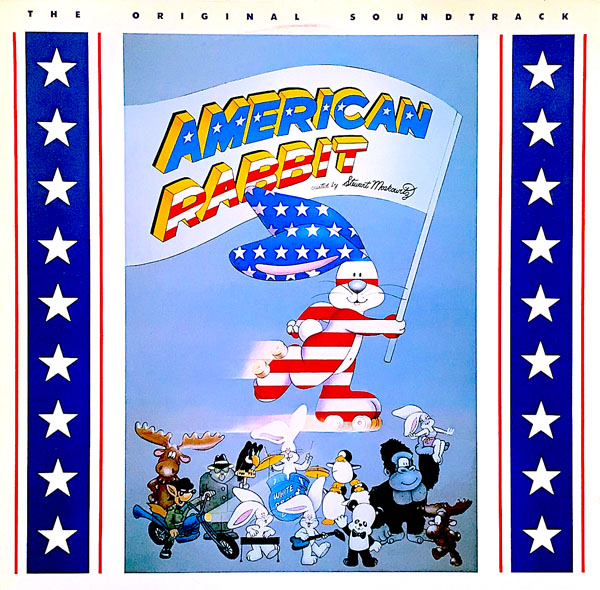
THE AMERICAN RABBIT
The Original Soundtrack
Mark Volman, Howard Kaylan and John Hoier
Rhino Records RNEP-70614 (12” 33 1/3 RPM / Stereo)
Producers: Mark Volman, Howard Kaylan, John Hoier.
Song: “As Long As You Can Rock and Roll” by Mark Volman, Howard Kaylan, John Hoier.
Instrumentals: “Main Title,” “School Band,” “Father and Son March,” “The Legacy/Flying,” “The Threatening Jackals,” “Meet Ping Pong,” “The Kidnapping,” “In Vultor’s Cave,” “Problems for Our Hero,” “Introducing Chocolate Mouse/The City.” “The Corporation,” “Torch It!” “Getting There,” “The Moose, the Statue, the Hero and the Villain,” “American Cities in Peril,” “Panic in the Streets,” “New Hope,” “Vultor’s Flight and Fall,” “The Grand Finale” by Mark Volman, Howard Kaylan, John Hoier.
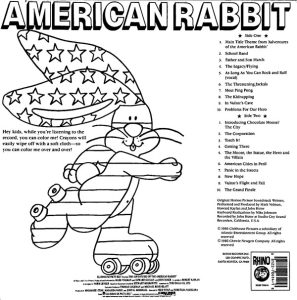 Throughout the history of animation, there are always periods in which the industry (and the corporations around which it orbits), ebb, flow and change. In the eighties, TV was experiencing an animation boom as cable and daytime suddenly sought new cartoons in larger quantities. In features, Disney was still either finding or reclaiming its identity, companies were buying each other like fishies, and talented artists dashed from place to place, from project to project. If there was a job to be done, they were there. Like superheroes with pencils.
Throughout the history of animation, there are always periods in which the industry (and the corporations around which it orbits), ebb, flow and change. In the eighties, TV was experiencing an animation boom as cable and daytime suddenly sought new cartoons in larger quantities. In features, Disney was still either finding or reclaiming its identity, companies were buying each other like fishies, and talented artists dashed from place to place, from project to project. If there was a job to be done, they were there. Like superheroes with pencils.
Fred Wolf’s accomplished career is one with such dash. We’ve explored some of his accomplishments in Animation Spins, as the director of the cartoons in the breakthrough TV special Free to Be … You and Me please read here) and the classic ABC TV movie The Point with Harry Nilsson (please enjoy here).
The Adventures of The American Rabbit may not be as instantly recalled as the other two projects, but it has quite a bit going for it, not the least of which is a score by former Turtles band members Howard Kaylan and Mark Volman. They were no strangers to children’s and family entertainment. They had already written and produced a stack of LPs for Kid Stuff Records starring the Care Bears (these are among the label’s best).
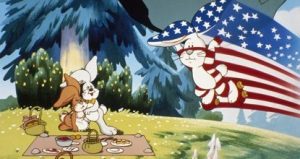 American Rabbit was a modestly-budgeted project. The score is performed on electronic equipment with percussion and other backup instrumentation. This album is a vinyl paradise for those who are devotees of eighties electronic cartoon music. Surprisingly, there were few animation soundtracks released back then with the electronic sound of this album, and as of this writing, it has not been reissued.
American Rabbit was a modestly-budgeted project. The score is performed on electronic equipment with percussion and other backup instrumentation. This album is a vinyl paradise for those who are devotees of eighties electronic cartoon music. Surprisingly, there were few animation soundtracks released back then with the electronic sound of this album, and as of this writing, it has not been reissued.
Clubhouse Pictures released the film. It was a short-lived family division of Atlantic Releasing, which began as an arthouse film distributor, branching into low-budget comedies, sci-fi, dramas, horror, and foreign co-productions. Between 1985 and 1987, Clubhouse released Teen Wolf, The Adventures of Mark Twain, a reissue of Hanna-Barbera’s first feature, Hey There, It’s Yogi Bear, and a few others.
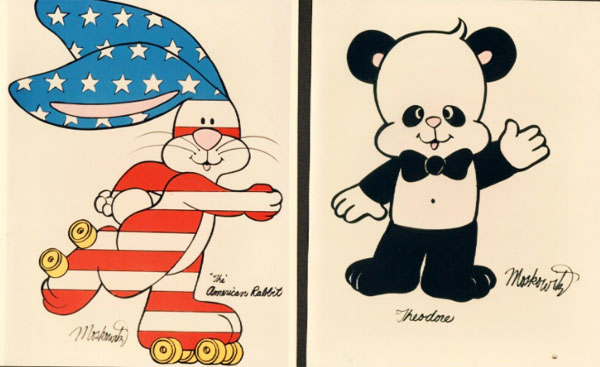
The story of The American Rabbit spoofs the Superman mythos, complete with a Clark Kent character, and even parents suggesting Jonathan and Martha Kent. The hero, Robert, learns that when he runs very fast, he transforms into a red, white and blue superhero (this was before Sonic the Hedgehog). “The American Rabbit” image itself was created by famed illustrator and author Stuart Moskowitz, who created popular posters of the rabbit. He wrote and illustrated a picture book that formed the basis for the feature film.
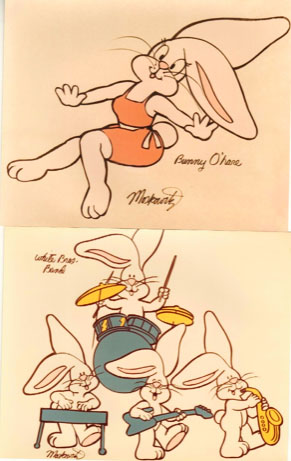 Rhino Records released the soundtrack when the label was only eight years old. Not by coincidence, Rhino gained their most considerable initial success with reissues of music by The Turtles. They became the “go-to” label for high-quality, expertly curated reissues of classic pop and unusual, long-awaited video. But the label had not yet ventured heavily into children’s products, so this album is a hybrid of sorts. It contains the musical score, a picture to color on the back, and a featured song, but no story told with dialogue. Had it been five or ten years later, Kid Rhino probably would have done a story album featuring the excellent dialogue.
Rhino Records released the soundtrack when the label was only eight years old. Not by coincidence, Rhino gained their most considerable initial success with reissues of music by The Turtles. They became the “go-to” label for high-quality, expertly curated reissues of classic pop and unusual, long-awaited video. But the label had not yet ventured heavily into children’s products, so this album is a hybrid of sorts. It contains the musical score, a picture to color on the back, and a featured song, but no story told with dialogue. Had it been five or ten years later, Kid Rhino probably would have done a story album featuring the excellent dialogue.
Like the music, the cast captures a sort of “state of the art” in eighties voice acting. Almost everyone in the cast has many credits: Barry Gordon plays the lead (he was the Nestlé’s Quik bunny and Donatello of Teenage Mutant Ninja Turtles); Kenneth Mars (this was his first animated feature, three years before The Little Mermaid; plus Russi Taylor, Hal Smith, Pat Fraley and lots more.
Of special note is Lorenzo Music, who, like Sterling Holloway, has a one-of-a-kind voice for many different characters but it works brilliantly every time. In this film, he plays Ping Pong, the most lovable gorilla since Magilla. This is the final film for Bob Holt, a veteran worthy of much more attention with so many credits that most everyone has heard him somewhere, including millions who enjoyed Disneyland read-along book and recording sets from the late seventies and early eighties.
American Rabbit has the same mellow spoken approach as The Point, even though it has a slicker, less underground look. The movement nevertheless has the style and timing of a Fred Wolf cartoon – it feels like The Point even though the look is quite different. The film also attempts to balance its intended audience by often putting the cute bunnies and animals in a grown-up setting, not a vulgar one, but one that is gritty and can be rough. There is great beauty on display throughout their journey from city to city but also a film noir texture as well.
The entire feature film has been posted here:
“As Long As You Can Rock and Roll”
You can’t have an album with Kaylan, Volman and bass player John Hoier without at least one song (well of course you can, but what fun is that?) In the film, Robert learns piano from his beloved mom, later plays in a club for his girlfriend, and joins a band. The band and the club in which it plays are at the emotional center of the story, as everything is set into motion once Robert becomes part of the club and the friends he meets there.


 GREG EHRBAR is a freelance writer/producer for television, advertising, books, theme parks and stage. Greg has worked on content for such studios as Disney, Warner and Universal, with some of Hollywood’s biggest stars. His numerous books include Mouse Tracks: The Story of Walt Disney Records (with Tim Hollis). Visit
GREG EHRBAR is a freelance writer/producer for television, advertising, books, theme parks and stage. Greg has worked on content for such studios as Disney, Warner and Universal, with some of Hollywood’s biggest stars. His numerous books include Mouse Tracks: The Story of Walt Disney Records (with Tim Hollis). Visit 





















































To a whole generation of kids, Barry Gordon was Donatello. But that’s not my generation! To me, he’ll always be Archie Bunker’s accountant and the kid who flirted with Jayne Mansfield in “The Girl Can’t Help It” — a film in which “As Long As You Can Rock and Roll” would not have been out of place.
Here’s a riddle: If the American Rabbit can fly, then why does he need to wear roller skates? Answer: Because it’s the ’80s!
I thought Bob Holt’s final animation credit was the first season of Disney’s The Adventures of the Gummi Bears”.
Anyway, I’ve seen this film but I didn’t find it spectaular (at least compared to what Disney was going to achive by the end of the decade). I recall Jerry giving this film a bad review in his “Animated Films” book.
I haven’t actually seen this movie, but from what I’ve read about it online, I can get a feeling for what it is – and it’s not great. A plot with more holes than swiss cheese, cardboard characters, dropped plotlines, and twists that make little to no sense. The movie was kind of a total dud, and it was probably a good thing that the Ninja Turtles dropped on Fred Wolf’s footstep and, for better or worse, permanently redefined his career (also DuckTales, which his studio worked on during the first season).
Atlantic Releasing made a lot of missteps in its attempts to make it big. While they had some successes like Teen Wolf and Night of the Comet, a huge chunk of their output was basically dead on arrival, the Clubhouse fare included, hence why the label died off so quick. The year before, they put out Starchaser: The Legend of Orin, which had been an even bigger flop. The year after the American Rabbit landed in theaters with a thud, Atlantic put out the disastrous Garbage Pail Kids movie, and it was all over for them. They didn’t make it to the 90s.
The entire movie is provided in the post.
Okay, I just sat through the entire American Rabbit movie, and it was pretty hard going, though not as much as the Ingmar Bergman double feature my date insisted on seeing back in college. What intrigued me most is that the villain’s name is, of all things, “Walt”. Walt is an empty suit who is later revealed to be a bald-headed buzzard, and I can’t help but wonder if there might be some personal intent behind that. Did Fred Wolf or screenwriter Norman Lenzer ever try to get a job with Walter Lantz and get turned down, and it still rankled years later? Of course, I get that vultures and jackals are both scavengers, hence kindred spirits, and that “Walt” might simply be derived from the name of their evil organisation, Vultor. Nevertheless, an animated feature with a villain named Walt — that’s something you don’t see every day.
Or was it that other Walt?
“Walt Sent Me”–password to get into Ink and Paint Club, Who Framed Roger Rabbit
Just like with another “Clubhouse Picture”, GoBots: Battle of the Rock Lords, I remember seeing commercials for this on TV for a very short time, then it was out of theaters almost immediately after it arrived. I actually wanted to see that GoBots movie as a kid, but since my mom didn’t take me on opening day it was gone before I had a chance to see it.
Toei worked on this film, too
Awesome, thank you! I remember watching this cartoon super hero when a was 4 years old.